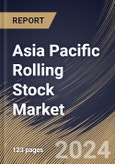High-speed trains represent a technological marvel in passenger transport, offering rapid and efficient connectivity between major cities. These trains are designed for high-speed travel, significantly reducing travel times, and enhancing the overall accessibility of different regions. Metro systems, commonly found in large cities, utilize these stocks for underground or elevated rail transit. They are instrumental in providing efficient and high-capacity transportation within urban areas, reducing dependence on private vehicles, and mitigating traffic congestion. In some cases, the stocks are adapted for military use to transport troops, equipment, and supplies. Military trains play a role in strategic mobility, supporting military forces’ rapid deployment and movement.
Specialized rolling stock is designed to transport automobiles, ensuring efficient and secure delivery from manufacturing plants to dealerships. These car-carrying trains enhance the logistics of the automotive industry. It equipped with refrigeration systems is utilized to transport perishable goods. This is crucial in maintaining the freshness and quality of products like food and pharmaceuticals during transit. Work trains are used for maintenance and construction activities on rail infrastructure. They transport personnel, equipment, and materials necessary for track maintenance, repairs, and upgrades.
According to the report titled Cities as Engines of Growth, published in 2022 by the Government of India, the population of urban areas in India is projected to have increased approximately fourfold, from 109 million in 1970 to 460 million in 2018. The country is projected to experience an additional 416 million inhabitants in its urban areas by 2050, resulting in a 50 percent urban population share. It is already the second-largest urban community globally. Similarly, as per the State Council of China, urbanization has accelerated rapidly throughout China in recent years, with the National Bureau of Statistics estimating that the rate increased to 64.72 percent last year. As of the end of 2022, 914 million people were living in cities, an increase of 12.05 million from 2021. Therefore, due to the above-mentioned factors, the market will grow significantly in this region.
The China market dominated the Asia Pacific Rolling Stock Market by Country in 2022, and would continue to be a dominant market till 2030; thereby, achieving a market value of $9,384.9 Million by 2030. The Japan market is registering a CAGR of 4.9% during (2023 - 2030). Additionally, The India market would showcase a CAGR of 6.2% during (2023 - 2030).
Based on Type, the market is segmented into Diesel, and Electric. Based on Product, the market is segmented into Wagon, Rapid Transport, and Locomotive. Based on Train Type, the market is segmented into Rail Freight, and Passenger Rail. Based on countries, the market is segmented into China, Japan, India, South Korea, Singapore, Malaysia, and Rest of Asia Pacific.
List of Key Companies Profiled
- Alstom SA (Alstom Transport)
- Kawasaki Heavy Industries, Ltd.
- Siemens AG (Siemens Mobility)
- Wabtec Corporation (GE Transportation)
- Hitachi, Ltd. (Hitachi Rail Systems)
- CRRC Corporation Limited
- Hyundai Motor Company (Hyundai Rotem Company)
- IHI Corporation (Dai-ichi Life)
- Mitsubishi Heavy Industries Ltd. (Mitsubishi Power, Ltd.)
- Trinity Industries, Inc. (TrinityRail)
Market Report Segmentation
By Type- Diesel
- Electric
- Wagon
- Rapid Transport
- Locomotive
- Rail Freight
- Passenger Rail
- China
- Japan
- India
- South Korea
- Singapore
- Malaysia
- Rest of Asia Pacific
Table of Contents
Companies Mentioned
- Alstom SA (Alstom Transport)
- Kawasaki Heavy Industries, Ltd.
- Siemens AG (Siemens Mobility)
- Wabtec Corporation (GE Transportation)
- Hitachi, Ltd. (Hitachi Rail Systems)
- CRRC Corporation Limited
- Hyundai Motor Company (Hyundai Rotem Company)
- IHI Corporation (Dai-ichi Life)
- Mitsubishi Heavy Industries Ltd. (Mitsubishi Power, Ltd.)
- Trinity Industries, Inc. (TrinityRail)
Methodology

LOADING...








